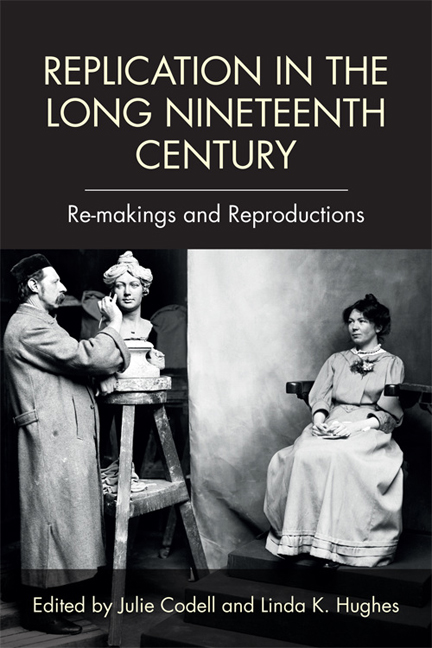Book contents
- Frontmatter
- Contents
- List of Illustrations
- Acknowledgments
- 1 Introduction: Replication in the Long Nineteenth Century – Re-makings and Reproductions
- I Replication and Networks
- II Replication and Technology
- 6 Replicating Tennyson's The Princess, 1847–1853
- 7 Paisley / Kashmir: Mapping the Imitation-Indian Shawl
- 8 William Morris and the Form and Politics of Replication
- 9 Text and Media Replication During the U.S.–Mexican War, 1846–1848
- III Replication and Authenticity
- IV Replication and Time
- Notes on Contributors
- Index
7 - Paisley / Kashmir: Mapping the Imitation-Indian Shawl
from II - Replication and Technology
Published online by Cambridge University Press: 11 August 2018
- Frontmatter
- Contents
- List of Illustrations
- Acknowledgments
- 1 Introduction: Replication in the Long Nineteenth Century – Re-makings and Reproductions
- I Replication and Networks
- II Replication and Technology
- 6 Replicating Tennyson's The Princess, 1847–1853
- 7 Paisley / Kashmir: Mapping the Imitation-Indian Shawl
- 8 William Morris and the Form and Politics of Replication
- 9 Text and Media Replication During the U.S.–Mexican War, 1846–1848
- III Replication and Authenticity
- IV Replication and Time
- Notes on Contributors
- Index
Summary
Introduction
The growing popularity of Indian textiles in the early nineteenth century prompted efforts by British manufacturers to capture a portion of the lucrative import market by imitating Indian shawls, most notably the exquisite patterned shawls of Kashmir. Although imitation-Indian shawls eventually proved enduringly popular and commercially successful, they were frequently derided as inferior in quality and workmanship (Martineau 553). Their ascendancy, driven by changes in taste and technology, was aided by the burgeoning culture of commodity consumption and the work of mid-century design reformers including Henry Cole. It coincided, moreover, with changing perceptions of both India and Scotland, home to the best-known imitation-Indian shawl manufactories.
Although imitation-Indian shawls were initially produced in several British cities, they were soon identified with Paisley, Scotland, where their quality and complexity of design had increased signifi- cantly by 1850. In his 1857 history of Paisley, John Parkhill wrote,
In 1805, the manufacture of shawls was introduced, and gradually became, and continues to be, the staple trade of the town. Imitation shawls of all kinds … have at different times been made here, such as thibet and cashmere shawls … Paisley may be said to be without a British rival [for imitation-Kashmiri shawls] … none but an experienced dealer can distinguish between a French and a Paisley shawl.
(Parkhill 94)The fame of Paisley's Kashmiri-derived shawls was such that “Paisley” quickly became a shorthand term for any imitation-Indian shawl, and eventually came to designate the teardrop-shaped design element properly known as the boteh (Figure 7.1). My analysis will therefore focus primarily on Paisley and on Kashmiri imitations. In tracing the varied and contradictory Victorian conceptions of Paisley shawls, I will sketch the industry's beginnings, examine the discourse of shawls in periodical literature, and consider the convergence of political, moral, and aesthetic issues touching shawl production in India and Scotland in John Ruskin's work. Analyzing the valences of the terms “imitation” and “copy” in discussions of authenticity, taste, and nationhood raised by Kashmiri and Paisley shawls, I argue, makes visible emergent conceptions of British and Scottish national identity that were inherently imperial in nature.
- Type
- Chapter
- Information
- Replication in the Long Nineteenth CenturyRe-makings and Reproductions, pp. 122 - 143Publisher: Edinburgh University PressPrint publication year: 2017



